
Swans, Ducks, and Geese
Swans, ducks and geese are found on every continent and throughout Oregon.

Types of Swans, Ducks, and Geese

The majestic trumpeter swan is the largest of our native waterfowl and one of the heaviest flying birds in the world with males sometimes exceeding 30 pounds.
Historically hunted to the brink of extinction, it was recognized as an endangered species long before there was an Endangered Species Act, and its recovery is a conservation success story.
The adult's snow-white plumage with contrasting black bill and feet and 8-foot wingspan define this magnificent bird. Their neck is as long as their body and is used to reach food at the marsh bottom.
In spring, the trumpeter swan is a locally common breeder east of the Cascades, most notably at Malheur National Wildlife Refuge. West of the Cascades, wintering birds are most consistently noted in west Polk Count and Sauvie Island, also along the northern coast, lower Columbia River, Forest Grove, and Trojan Nuclear Power Plant.
Trumpeter swans are an Oregon Conservation Strategy Species in the Blue Mountains, East Cascades and Northern Basin and Range ecoregions.
Hear the call of the trumpeter swan
Photo by Dave Budeau, ODFW

Greater scaup are almost the size of redheads. In hand, they are easily distinguishable from lesser scaup by size and by the white wing stripe extending beyond the secondaries into the primaries. In the field the two species are sometimes difficult to separate. Drakes are black on both ends and white in the middle. Hens are dark brown with a white mask around the base of the bill.
The common vocalizations are the discordant scaup and purring pbbbrr of the female. Greater scaups form large flocks, sometimes mingling with lesser scaups in fall and winter.
They are an abundant migrant and winter visitant in the Columbia River estuary and common to abundant on coastal bays and lower river segments. Except for regular occurrence in the Columbia River estuary and Coos there are few summer records.
Hear the call of the greater scaup
Photo by Paul Sullivan, Flickr

The skies near favored stopover locations are filled twice annually with the sights and sounds of these geese as they migrate between Arctic breeding grounds and wintering areas farther south. Snow geese share very similar all-white plumage and black wing tips with the less common Ross's goose. These are Oregon's only wild white geese.
It is predominantly a spring and fall migrant, especially abundant in large wetland and agricultural complexes such as Malheur National Wildlife Refuge, Silvies River floodplain in Harney County, Lower Klamath National Wildlife Refuge and Klamath Wildlife Area. Wintering snow geese in Oregon are found primarily along the lower Columbia River between the mouth of the Willamette River and Astoria. Summer Lake Wildlife Area is also a great place to see these birds.
Hear the call of the snow goose
Photo by Dave Budeau, ODFW
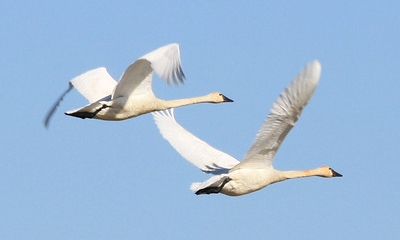
Of several swans found in Oregon, the tundra swan is by far the most common during the non-breeding season. It is most readily distinguished from the similar-appearing trumpeter swan by voice, although subtle differences in physical appearance and behavior can separate the two with difficulty.
It is a fairly common transient throughout the state but most abundant at large bodies of water and wetland complexes east of the Cascades including the Malheur National Wildlife Refuge and the surrounding Harney Basin, Summer Lake Wildlife Area and the Klamath Basin.
Hear the call of the tundra swan
Photo by Kathy Munsel, ODFW

Known as "bluebill" to most hunters, this species is one of the most abundant and widespread of North American ducks.
The lesser scaup is similar to the greater scaup in appearance and habits, but is smaller and lacks the white on the primaries. In the field, however, the black-and-white drakes and brown hens are very similar to greater scaups.
The common vocalization is the purr call of the female; drakes are usually silent, but utter a low single-note whistle in courtship. In general, the lesser scaup is more apt to be found in interior or freshwater habitats while the greater scaup is more a coastal bird.
It is an uncommon breeder at Malheur National Wildlife Refuge and is an occasional summer and very local nester in northeast Oregon.
Hear the call of the lesser scaup
Photo by Kathy Munsel, ODFW

This small white goose is similar in plumage to the snow goose in all ages. In mixed flocks, the Ross's smaller size, shorter neck, head and bill profile and more rapid wing-beat may be apparent.
They are a common spring and fall migrant through Klamath and Harney basins. During migration and on wintering grounds, the Ross's goose uses lakes and shallow marshes for roosting and agricultural crops and irrigated hay meadows for feeding.
They arrive in Oregon around mid-October and leave around mid-November to continue their migration. They are a common spring and fall migrant through Klamath and Harney basins.
Hear the call of the Ross's goose
Photo by Charlotte Ganskopp

The drake wood duck is the most colorful of North American ducks. The brown hen has similar features including a crest, distinctive white eye-ring, white belly and purplish-blue iridescence on wing coverts and speculum. Both sexes have a prominent tail that can be a field mark in flight.
As their name implies, they are associated with timbered wetlands, nesting in cavities and sometimes even feeding in trees. Hens utter a fairly wide range of un-duck like sounds, but most common is a loud wee-e-e-e-k, wee-e-e-e-k.
It is a regular breeder in the Willamette Valley, along slow reaches and backwaters of the Cascade and Coast Range rivers, lakes, and ponds, and along the Columbia River and coastal counties.
Hear the call of the wood duck
Photo by Jones

This small, boldly-patterned duck can be found in Oregon throughout the year, either around rocky headlands on the coast or inland on mountain streams.
No other breeding duck in Oregon feeds almost exclusively on benthic invertebrates, often swimming underwater and upstream against swift current in search of prey.
Though males are striking in appearance, these and the drab brown females can be difficult to see when at rest on a mid-stream rock or dodging behind rocks as they evade observers.
Broods have been observed or nests located on tributaries in the river basins of the west Cascades. They are found at the Oregon coast throughout the year. Larger concentrations of wintering birds are usually seen in Lane, Lincoln and Coos counties.
The harlequin duck is an Oregon Conservation Strategy Species in both the Coast Range and West Cascades ecoregions.
Hear the call of the harlequin duck
Photo by ©Keith Kohl, ODFW

With four wing-beats each second pushing them to 62 miles per hour, brant are the fastest and strongest geese in flight and among the swiftest of all large birds.
Black brant comprise the vast majority of brant occurring in Oregon. These small geese have smoky black backs and bellies, and dissected white collars and white around the tails provide striking contrast. The black brant can live up to 20 years and are resilient enough to ride out storms on the open ocean.
In Oregon, wintering numbers along the coast have seen a 50 percent reduction from previous years due to the degradation of their habitat. Flocks of as many as 2,100 occur along the Coos County coast during northward migration in March and April. Black brants are rare inland, usually occurring as individuals among flocks of cackling Canada geese.
The black brant is an Oregon Conservation Strategy Species in the Coast Range and Nearshore ecoregions.
Hear the call of the black brant
Photo by Dave Budeau, ODFW

The drake gadwall is a large mostly gray dabbling duck. Adult drakes have a black bill, buff head, gray body, and black upper and lower tail coverts. Hens are nondescript brown ducks with a spotted, yellowish-orange bill with black edges. Gadwalls are unique among dabbling ducks in having a partly white speculum which can be observed in flight.
Common vocalizations include the deep, reed-like sounds of the male and the female's quacking, similar to but more nasal and higher pitched than the mallard hen.
It is an abundant breeder locally in eastern Oregon and an uncommon breeder in western Oregon. It is also a common to abundant spring and fall migrant in eastern Oregon.
Photo by Nick Myatt, ODFW
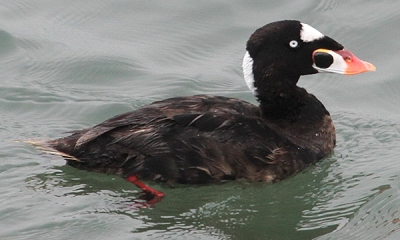
Although the least numerous scoter on the continent, it is the most common scoter along the Pacific coast south of Alaska and winters by the thousands off Oregon.
Adult males' plumage, black except for white patches on the forehead and nape, yields attention to the bill, a swollen white, red-orange, yellow, and black wedge feathered squarely along its base. The highly visible standard advertises male's presence for up to a mile.
Dark-billed adult females and subadults are dark brown above and paler brown below, with two indistinct light patches on the cheeks and sometimes on the nape. A flattened head profile and heavier bill distinguish this species from other scoters.
The surf scoter is abundant on salt water along the coast from fall through spring and uncommon during summer. It is uncommon on fresh water near the coast, and does not breed in Oregon. Inland, several are recorded from west of the Cascades and a few from eastern Oregon most years, usually in fall on large lakes and reservoirs.
Hear the call of the surf scoter
Photo by Justin Ainswoth, ODFW
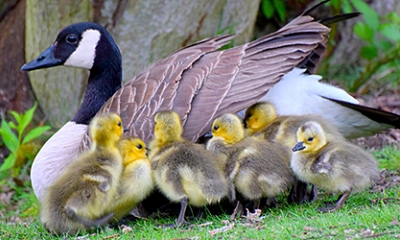
Canada geese, with their distinctive black neck and head and white cheek patches, need little description because they are one of Oregon's most familiar and conspicuous birds. There are 11 subspecies of the Canada goose.
As a whole, the species is widely distributed throughout Oregon, with the exception of mountainous and desert areas lacking reservoirs, lakes, or large rivers. Concentrations of wintering and breeding Canada geese occur wherever agriculture and other human developments provide green forage or small grains and water bodies provide sanctuary.
Hear the call of the Canada goose
Photo by Leise Wease

This foreign visitor is regularly found in Oregon among wintering flocks of American widgeon. Drakes are easily distinguished from American wigeon drakes by reddish brown head, gray flank, and lack of green eye stripe. Hens are similar to American Wigeon hens and difficult to distinguish.
The call of the male is a shrill whistling, whe'e you; the female's voice a low purr or croak.
It is a rare to uncommon visitant east of the Cascades.
Hear the call of the eurasian wigeon
Photo by ©Greg Gilson
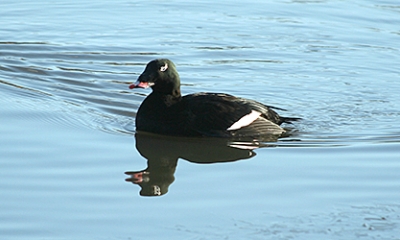
The white secondaries of the white-winged scoter in all plumages form a conspicuous square wing patch during flight but are often hidden during rest. Other than the secondaries, males' plumage is entirely black except for a small white teardrop around each eye.
Females and immatures are dark brown above and pale below with diffuse white patches in front of and behind the eyes. A black knob graces the males' swollen, white-ridged, orange bills, while females' and immatures' bills are dark; the feathering of all extends almost to the nostril.
Abundant along the coast from fall through spring, white-winged scoters are uncommon during summer on the ocean and inshore marine waters.
Hear the call of the white-winged scoter
Photo from ODFW
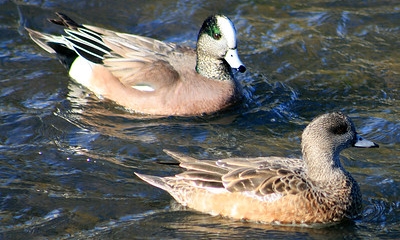
Wigeon drakes are beautifully marked with white pate, green eye stripe, purplish breast and flanks, white belly and wing covert patch, and iridescent black/green speculum. The grayish hen shows white on the wing covert patch.
Drakes give a three-note whistle and get progressively noisier as spring approaches and courting flights begin.
Medium sized flocks are common in fall and winter, and like geese, will be found grazing pastures, park lawns, and golf courses.
It is a rare to locally common breeder in eastern Oregon and rare in summer in western Oregon. It is a common to abundant migrant and wintering bird statewide. In northeast Oregon, it is an uncommon summer resident, but nests locally at Ladd Marsh Wildlife Area.
Hear the call of the American wigeon
Photo by Kathy Munsel, ODFW

Adult male scoters of all species are black, but black scoters are the blackest; their shiny black plumage bears no white. The swollen bright orange-yellow knob on the otherwise black bill is smaller than that of other scoters.
Males are distinguished in flight by the flashing silver-gray of underwing flight feathers against black wing linings and the all-black body. Females' uniform soot upperparts and dark head cap are clearly delineated from paler cheeks; their bills are usually dark. Immatures resemble females, but most males acquire some black feathering the first fall.
This scoter can be uncommon to locally common along the coast fall through spring, usually on the ocean.
Hear the call of the black scoter
Photo by Aaron Maizlish, Flickr
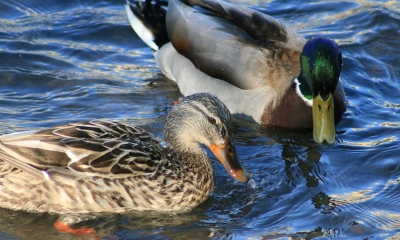
When mention is made of ducks, many people first think of the mallard. Its ability to tolerate human disturbance and adapt to urban as well as rural habitats make it the Northern Hemisphere's most abundant and widespread waterfowl.
Females are mottled-brown, with dark brown stripe through the eye, orange bill with black splotching and have yellowish-orange legs. Immatures resemble adult females until males acquire nuptial plumage usually by mid-November. Males enter the eclipse molt in June and resemble hens until mid-September. Wings of both sexes have a violet-blue speculum bordered in front and behind by a pronounced white stripe.
They are a common transient and summer and winter resident throughout the state.
Photo by Kathy Munsel, ODFW

This restless diver of cold oceans and bays is one of the prize waterfowl to see on a coastal winter day. Although the loud, musical call of males is seldom heard in Oregon, we can still be cheered on a chilly day by this energetic visitor from the north.
The winter males' body is mostly white except for a black breast and central back; the wings are dark, scapulars long and gray, and the dark central tail feathers elongate. Winter females are darker above with a light head; scapulars and tail feathers are short and dark. Dark areas mark females' heads and males' necks.
Long-tailed ducks are rare to uncommon winter visitors along the coast and inland on the Columbia River and on lakes throughout the state. They typically occur singly or in pairs but groups of up to 13 have been observed along the coast.
Hear the call of the long-tailed duck
Photo by Will, Flickr
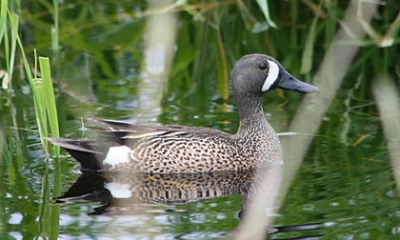
The blue-winged teal is one of Oregon's least common ducks. It is a small, warm-weather duck usually found in Oregon only from late spring until the weather cools in early fall.
Except for adult drakes in alternate plumage, blue-wings are difficult to distinguish from cinnamon teal. For that reason its status in Oregon is less clear than that of other ducks. Adult blue-wing drakes have a gray head with white crescent between the eye and bill. Hens and young of both species are nondescript small brown ducks, but show the prominent blue wing-covert patch in flight.
It is an uncommon summer resident and common spring and fall migrant in northeast Oregon.
Hear the call of the blue-winged teal
Photo by Cathy Nowak, ODFW
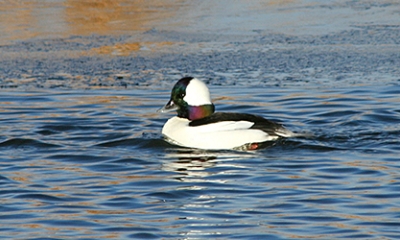
The bufflehead is North America's smallest diving duck, giving it the advantage of being able to nest in abandoned holes of northern flickers, a plentiful resource off limits to larger cavity-nesting ducks.
It is a swift flyer and takes wing from water more easily and neatly than other diving ducks. Widely distributed throughout the state in winter, males attract attention with their striking white body, black back, and iridescent black head with a large notch of white; females and juveniles are dark charcoal-gray with a conspicuous white patch behind and below the eye.
It is a local, uncommon breeder in the central and southern Cascades but is rare away from breeding locations. it is a common migrant throughout the state in both spring and fall. It winters throughout Oregon.
Hear the call of the bufflehead
Photo by Cathy Nowak, ODFW
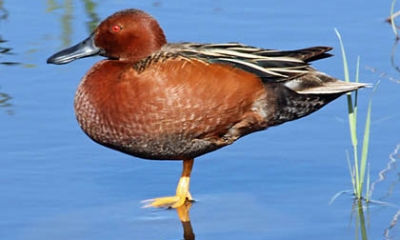
The bright rusty plumage of the male cinnamon teal, a bird of western North America, is a visual delight. In flight, both males and females show powder blue in the wings as they fly fast and low, timed at nearly 60 miles per hour. They weigh only about one pound.
They are a common breeder throughout the state except in western Oregon and the high Cascades. They are most common east of the Cascades.
Hear the call of the cinnamon teal
Photo by Maxine Wyatt
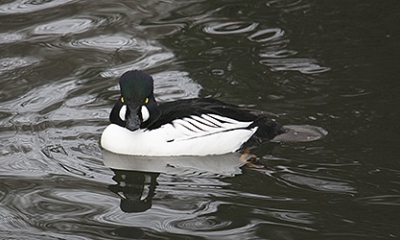
The common goldeneye drake is a strikingly handsome black-and-white diver about the size of a greater scaup.
Goldeneyes are strong, fast flyers nicknamed "Whistlers" for the sound of their primaries as they zoom past on a still day.
Drakes have a black head with a white spot below and in front of the eye, white neck, breast and flanks and a black back and tail. Hens have a brown head, light neck, breast and belly, brown backs and flanks.
They are fairly silent and usually alone or in small groups. They tend to remain apart from other ducks.
It is an extremely rare summer visitor in northeastern Oregon and casual to rare in summer in the Klamath Basin. It is a common spring and fall migrant in northeastern Oregon and in winter on the Snake River, the entire course of the Columbia River, and the Klamath River.
Hear the call of the common goldeneye
Photo by Kathy Munsel, ODFW
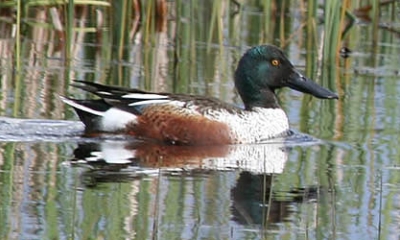
The Northern shoveler's specialized bill earned it in the nickname "spoonbill" among waterfowl hunters. The drake is strikingly handsome with a dark head, white breast, reddish belly, blue wing coverts and an iridescent green speculum. Brown hens also have blue wing patches similar to that of the cinnamon and blue-wing teal.
This duck is locally common in summer in eastern Oregon and uncommon in western Oregon. It is a common spring and fall migrant statewide.
Hear the call of the Northern shoveler
Photo by Kathy Munsel, ODFW

Medium-sized diving ducks, Barrow's goldeneyes are the expected of the two goldeneye species in Oregon in the summer, but are typically less numerous in the winter.
Drakes show graceful patterns of black and white, purple glossed head, white crescent-shaped patch between the eye and bill, steep forehead, and short bill. Females and juveniles have a chocolate-brown head, slate-gray back, wings and tail; adult females have a golden bill.
They are the only waterfowl species known to defend winter territories different from breeding territories.
It is uncommon from the Cascades eastward in both breeding season and winter, but it may concentrate in winter at certain favored spots.
Hear the call of the Barrow's goldeneye
Photo by Tom Koemer

The pintail is a large, long-necked duck of open spaces. The long-tailed, full-plumaged drake is striking with a chestnut head, gray back and flanks, bright white breast and front of neck, and iridescent green bronze speculum. The brown hen is nondescript, but shares the long neck and graceful shape of the drake.
Common vocalizations are the two-note flute-like whistle of the drake and harsh gaak, either single or in a series, of the hen.
In fall and winter, pintails travel in medium to large flocks. In Oregon, flocks seem to fly exceptional distances in daily foraging and can be seen traveling many miles from their roost. It is an uncommon to common breeder and abundant migrant east of the Cascades. It is a rare breeder, but an abundant migrant and winter visitant west of the Cascades. It is a common spring and fall migrant in northeast Oregon.
Hear the call of the northern pintail
Photo by ©Greg Gilson
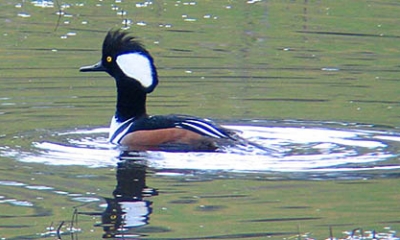
In quiet backwaters and wooded wetlands, these stunning ducks can occasionally be seen skulking near the shoreline as they search for fish.
The male with a striking black head and extensible white crest, white breast, black back, and chestnut sides is truly a sight to behold. Females and immatures are quite plain by comparison: dull grayish-brown except for a reddish brown crest.
Hooded mergansers are surprisingly secretive and local during the breeding season. They breed locally throughout the Willamette Valley west to the coast and south to Coos County. They are casual from April to early October in the Umpqua Valley. During migration it is widespread through uncommon across Oregon, usually in sheltered areas of lakes and ponds and less commonly on estuaries. It winters throughout Oregon on open water, though it is most common in western Oregon.
Hear the call of the hooded mergansser
Photo by ©Greg Gilson

The green-winged teal is the smallest North American dabbling duck. In alternate plumage, green-wing drakes have a cinnamon-colored head with a green eye-stripe, gray back, flanks, and wing with a iridescent green speculum. Hens are brown with a green speculum.
This duck is mainly a migrant and winter visitor. It is an uncommon summer resident and breeder in northeastern Oregon and a rare summer resident west of the Cascades.
Hear the call of the green-winged teal
Photo by Kathy Munsel, ODFW

A white form on the distant water may be the sides and breast of an adult male, whose deep green head and dark back are less visable when far away.
The pearl gray bodies and white breasts of females, subadults, and eclipse males are starkly delineated from their full-crested chestnut heads. Long, slender, saw-tooth bills are held horizontally during surface swimming and grip squirming prey after an underwater chase.
From coastal bays to the high Cascades, in all corners of Oregon and far beyond, common mergansers ply the rivers and peer into still waters in their efficient pursuit of fish. This merganser breeds commonly in mountainous areas but is nearly absent as a breeder in the Colombia and Great basins, where open water is scarce.
Hear the call of the common merganser
Photo by ©Greg Gilson

Canvasbacks are large; adults in good condition are as heavy as mallards and second in size only to the white-winged scoter among common Oregon ducks.
Drakes have a reddish head and neck; black breast, lower back and tail coverts; nearly white back, flank, and belly, and dark gray tail. The hen is grayish brown with a darker brown head, neck, breast and tailcoverts.
It is an occasional summer resident in northeast Oregon, nesting locally only at Ladd Marsh in Union County. It is an uncommon spring and fall migrant in northeastern Oregon and regular in winter and spring on the Umatilla National Wildlife Refuge complex in Morrow and Umatilla counties.
Hear the call of the canvasback
Photo by Kathy Munsel, ODFW

Swimming and diving with grace and energy, red-breasted mergansers arrive in fall but save their complex, contorting courtship display for early spring.
A ragged-crested dark green head and reddish brown breast mark the male, along with a dark back and gray sides.
Females share the ragged crest; their rufous heads and gray bodies may make separation from common merganser females difficult. Their bills, however, are noticeably slimmer.
Red-breasted mergansers are common from fall through spring, mostly in coastal bays and estuaries but occasionally on the open ocean.
Hear the call of the red-breasted merganser
Photo by ©Greg Gilson

Although not as imposing as the Canvasback, the redhead is a large, handsome, fast-flying diver.
The drake has a red head, black breast and tail coverts, and steel gray back, flanks and tail. Hens are a medium brown. During courtship, the drake utters a very un-duck-like meow.
Known for nest parasitism - laying eggs in the nests of other birds, usually other diving ducks - redhead eggs have also been found in the nests of a variety of species.
It is an uncommon summer resident in northeast Oregon, but commonly breeds at Batch and Bogus lakes and locally elsewhere in Malheur County.
Photo by Kevin Bercaw, ODFW
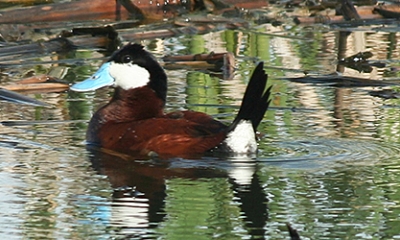
Small in size and displaying a showy, almost comical alternate plumage, the male ruddy duck is an unforgettable sight.
Breeding males are unmistakable with their rich chestnut back, black crown, white cheek, sky-blue bill, and proportionately long stiff tail. Female plumage is drab in comparison, being dusky dark brown with a dark facial strip across the mostly white cheek, quite similar to the male's basic plumage.
Known for their peculiar courtship display in which the male draws his head down and slaps his bill against his breast repeatedly in increasing tempo, creating a bubbling in the water and a hollow tapping sound. A consummate diver, this bird rises off the water only after an industrious pattering along the surface, and is nearly helpless on land.
The ruddy duck is locally common east of the Cascades in summer, particularly in freshwater marsh complexes in south central and southeastern Oregon.
Hear the call of the ruddy duck
Photo by David Bronson, ODFW

The ring-necked duck, which would have been better named "ring-billed duck" and is called "blackjack" in the southeastern United States, frequents different habits than the scaups with which is is often confused.
The black back, white crescent on the side just in front of the wing, and white-ringed bill separate the drake ring-neck from the scaups. The brownish neck ring of the male in alternate plumage is not prominent. The hen is a small dark brown duck with a buff face. Drakes in courtship give a head-throw accompanied by a wow note while hens utter a growling purr.
Ring-necks are uncommon summer residents in northeast Oregon and occasional breeders at lakes with emergent vegetation in Malheur County.
Hear the call of the ring-necked duck
Photo by Dave Budeau, ODFW

While not as abundant or conspicuous as the more familiar Canada and snow geese, the great white-fronted goose represents one of the first signs of fall.
The greater white-fronted goose is gray-brown in body color and has orange feet. Adults have the namesake white forehead, pinkish-orange bill, and black speckled/barred breast and belly.
Laugh-like calls from small skeins of these birds are heard high overhead in August through September in the north Willamette Valley and across the Cascades to south central Oregon and northeast California.
Hear the call of the greater white-fronted goose
Photo by Dave Budeau, ODFW
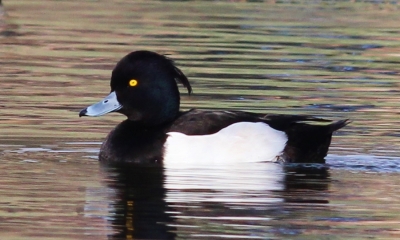
This Eurasian diving duck regularly occurs in the Aleutian Islands and with increasing regularity in North America, especially along the West Coast. It is now reported annually in Oregon, between mid-October and early May, with most during January and February. All were from the coastal lowlands or the Willamette Valley, except for one on a small pond in Josephine County.
They are closely related to the scaups and often associated with them.
Hear the call of the tufted duck
Photo by Tom Benson, Flickr

The emperor is a medium-sized stocky goose with a white head and metallic blue-gray body reminiscent of a blue-morph snow goose. Dark throat and undertail coverts as well as yellow feet distinguish it from the latter. Juveniles are brown with a gray-black head and neck that becomes white with black flecking in late fall.
Vocalizations include in-flight kla-ha, kla-ha, kla-ha, and an alarm call a deep ringing u-lugh, u-lugh, u-lugh. The emperor is a rare but regular visitor in Oregon during migration and in winter, most commonly on the coast.
Hear the call of the emperor goose
Photo from USFWS

